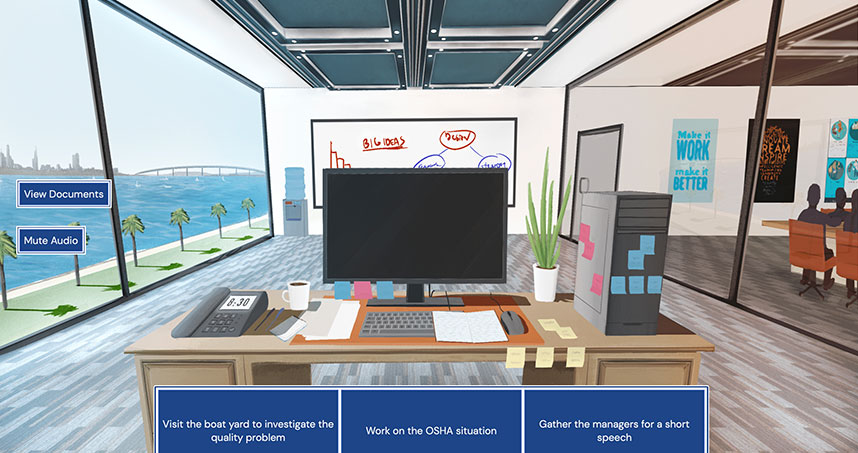Making a Game out of Case Studies
Professor William White turned business case studies into immersive interactive stories
It’s your first day in charge of Yellowtail Marine, a San Diego-based boat manufacturer. You’re scheduled to fly to Miami to meet with a potential customer, but there’s an issue in production that needs urgent attention. Two investigators from the Occupational Safety and Health Administration are at headquarters, waiting to inspect your facility. Meanwhile, your new staff wants to hear from you.
What is your first priority? How do you handle each situation? What do you delegate? It’s up to you to decide, but it’s clear each path has its own potential pitfalls that could lead to negative feedback from employees and poor results for your company.

These are the challenges faced in one of the video game-like immersive interactive stories developed by William White, professor of industrial engineering and management sciences, for his IEMS 342: Organizational Behavior course this fall that is completely remote. With an included dossier, the web-based experience that uses video game-like sounds and visuals that feel like a video game, places students at the head of a company and forces them to make decisions. A good decision adds points to their score; a bad one knocks them back and could be greeted with a clip of Michael Scott from “The Office,” whose management students obviously don’t want to emulate.
“This new, immersive case study gives students an interactive opportunity to think about how they would behave if they were in charge,” White said. “It’s about making decisions with the information at hand, and then dealing with the consequences once you own the decision.”
Just like in life, what the right decision is can change. To mimic this, White added a random number generator, which means the same decisions made in two different attempts could lead to different results. The experiences expose students to complicated real-life problems, and then they identify the tools and principles to solve the issues encountered.
This experiential course is a way to add engagement for his students, White said. After the quick move to online classes in March, White is now looking to refine the educational experience for the fall and beyond.
“We’re finding more ways to be interactive,” White said. “Everybody's working to engage students, and that makes a big difference."
Over the summer, White enlisted the help of IEMS student Ben Nelson Bentley to create the experiences, but the pair quickly realized they would need assistance from a few students who had experience working on video games. White and Bentley reached out to Pioneers of Interactive Entertainment, a club on campus that allows students to explore interactive entertainment and game development as a field of interest, and recruited developers Austin Lopez, David Wang Zhang, Caleb Calvillo (computer science), and Joshua Hoffman (Weinberg College of Arts and Sciences).
Together, they turned the case studies White uses in traditional classes into the immersive interactive stories that are tailor-made for remote learning. They did so despite the challenges posed by COVID-19, one of which was communication.
“This was resolved by creating a Slack channel where everyone was instructed to upload their most recent version of their work to provide visibility to the rest of the team,” said Bentley, from Houston who expects to graduate in 2021. “This way, every member of the team could see what progress had been made on each of the interactive stories, which prevented multiple people from working on the same thing.”
The team looked at which formats could be used to turn each case into a game. They discussed points systems, interactive elements, media such as videos and photos, content, and design. Though there will be four different stories used in the fall course, the team of developers wanted each experience to feel like it was a series that was part of the same class. Still, they changed the structure and design enough to make each story feature its own twists and unique elements to keep them interesting.
“We thought we could take some ideas and elements from video games and then find an architecture where we could deliver the academic content,” White said. More immersive interactive stories are in the works for this quarter and also the future.
The games utilize a “choose your own adventure” format. Other elements, such as hidden Easter eggs and interactive maps, were added, compelling students to try the stories multiple times.
Hoffman, a second-year student from Wilmette, Illinois, learned during spring quarter that it can be hard to stay engaged during a Zoom lecture. This experience eases that challenge.
“With so many distractions, it is easy for your eyes to leave the screen or for students to tune out,” Hoffman said. “Adding something where the student actually has to interact, but in a more engaging and meaningful way, will help students stay focused on the material. Competing for points and leaderboard positions works in online games, why not the classroom?”
